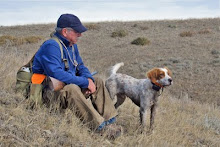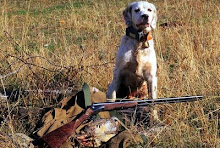This might have been a very different post if the outcome had been any different, but I am happy to report that Mr. Enthusiasm has arrived safely home.
I should point out that we invested in a Deer Creek Uplanderdogbox roughly three years ago when we became a two-dog household and it was pretty obvious we were going to be driving a lot with our two dogs. Even leaving aside how (literally) cool these insulated boxes can be, or how convenient the top storage compartment is, this was one of our best investments because of the extra protection these boxes offer our dogs while driving. Mercifully, I don't have any horror stories to tell about close calls -- but I have peace of mind knowing that my dogs can't be catapulted around should an accident befall us.
At first, because Jozsi was flying out of Phoenix, I thought I'd have to go out there and drive him back because the temperature at the airport would be too high in mid-September. I then discovered that this was largely urban myth and that individual airlines maintain their own guidelines for when and where they will fly dogs. Then, at this point in my research, of course, there were the seven puppies who died on an American Airlines flight in early August from Tulsa to Chicago. Another friend then mentioned that there was an airline that only flew dogs and cats -- Pet Airways, surprisingly enough -- and in the main cabin, to boot.
The deal with Pet Airways is that they are, I believe, a single plane operation and essentially fly out of nine regional airports across the country, all close to major metropolitan areas. So, for example, they do fly in and out of 'Phoenix' and 'New York' - but these are actually Falcon Field in Mesa and Republic Airport in Farmingdale. They essentially fly eastbound on Tuesdays and Wednesdays and westbound on Thursdays and Fridays, normally with a stop-over in Omaha. It all looks pretty slick.
They are a single-plane operation, however, with limited space and are pretty adamant about folks making reservations for the correct size crate. One thing to keep in mind before flying your bird-dog is that the USDA regulates travel crate sizes, not the individual airlines. As theirregulations state: "Primary enclosures used to transport dogs and cats must be large enough to ensure that each animal contained in the primary enclosure has enough space to turn about normally while stand, to stand and sit erect, and to lie in a natural position." (Regulation 3.14.e.1) Call me inhumane, but part of the point of a dog-box is that your dogs can't move around entirely freely (so that in the event of an accident, they don't become a projectile). In any case, keep in mind that the crate you have at home is probably smaller than the one you'll be expected to fly your dog in.
What this means with regard to Pet Airways is that, interestingly enough, in the time between when I first started researching flying Jozsi with them and now, they have changed their website reservation process so that owners can no longer choose which size carrier their dog will fly in, but have to input their dog's height (when standing erect) and weight. I presume that their policy of no refunds is still in effect if you reserve a smaller crate size than necessary to save money and there are no larger crate spaces available on your dog's flight. And there are, of course, a limited number of larger-sized crates on each plane so if you decide to go this route and have an average-sized pointing dog, book well in advance.
I did also call Continental Airlines to inquire about their PetSafe flight program and was immediately impressed by the agent who picked up my call. If she even used a computer to tell me how I could fly my dog on a direct flight from Phoenix to the East Coast, I would be genuinely surprised. It took less than two minutes for her to tell me the Phoenix SkyHarbor flight limitations (e.g. before September 15th, they won't fly a dog later than 8:00am, period), flight numbers, flight times, and cost. When I did call again, the representative who made the reservation was equally thorough and well informed. And frankly, by contrast, the representative at PetAirways sounded both a little vague and a little smug. If there had been space on a PetAirways flight that worked for us, would I have still flown my dog on Continental? That's a tough call, but I have to say that I felt a little played -- as if not flying your dog in the main cabin was somehow not doing the best for my dog.
Nevertheless, the spectre of those seven puppies nagged at me. Honestly. But this was my thought process. Since mid-2005, commercial airlines have been required by the US Department of Transportation to track killed, lost, or injured pets on its flights. As this blogarticle about that tragic American Airlines flight points out, the US Department of Transportation has records of only 122 pet deaths in five years. Again, I appreciate that if one of these 122 dogs were one of mine, I might be writing a different story. But statistically speaking, unlike those 7 very young dogs in Chicago, the chances of anything disastrous happening to my super-fit, crate-acclimatized three-year-old were slim. And I imagine that those odds are also significantly slimmer than putting my dog in a crate in a rental car and driving on the nation's highways for four days straight. I can't find any statistics for how many dogs are killed in automotive accidents, but I strongly suspect that it's more than 122 in five years.
The deal with Pet Airways is that they are, I believe, a single plane operation and essentially fly out of nine regional airports across the country, all close to major metropolitan areas. So, for example, they do fly in and out of 'Phoenix' and 'New York' - but these are actually Falcon Field in Mesa and Republic Airport in Farmingdale. They essentially fly eastbound on Tuesdays and Wednesdays and westbound on Thursdays and Fridays, normally with a stop-over in Omaha. It all looks pretty slick.
They are a single-plane operation, however, with limited space and are pretty adamant about folks making reservations for the correct size crate. One thing to keep in mind before flying your bird-dog is that the USDA regulates travel crate sizes, not the individual airlines. As theirregulations state: "Primary enclosures used to transport dogs and cats must be large enough to ensure that each animal contained in the primary enclosure has enough space to turn about normally while stand, to stand and sit erect, and to lie in a natural position." (Regulation 3.14.e.1) Call me inhumane, but part of the point of a dog-box is that your dogs can't move around entirely freely (so that in the event of an accident, they don't become a projectile). In any case, keep in mind that the crate you have at home is probably smaller than the one you'll be expected to fly your dog in.
What this means with regard to Pet Airways is that, interestingly enough, in the time between when I first started researching flying Jozsi with them and now, they have changed their website reservation process so that owners can no longer choose which size carrier their dog will fly in, but have to input their dog's height (when standing erect) and weight. I presume that their policy of no refunds is still in effect if you reserve a smaller crate size than necessary to save money and there are no larger crate spaces available on your dog's flight. And there are, of course, a limited number of larger-sized crates on each plane so if you decide to go this route and have an average-sized pointing dog, book well in advance.
I did also call Continental Airlines to inquire about their PetSafe flight program and was immediately impressed by the agent who picked up my call. If she even used a computer to tell me how I could fly my dog on a direct flight from Phoenix to the East Coast, I would be genuinely surprised. It took less than two minutes for her to tell me the Phoenix SkyHarbor flight limitations (e.g. before September 15th, they won't fly a dog later than 8:00am, period), flight numbers, flight times, and cost. When I did call again, the representative who made the reservation was equally thorough and well informed. And frankly, by contrast, the representative at PetAirways sounded both a little vague and a little smug. If there had been space on a PetAirways flight that worked for us, would I have still flown my dog on Continental? That's a tough call, but I have to say that I felt a little played -- as if not flying your dog in the main cabin was somehow not doing the best for my dog.
Nevertheless, the spectre of those seven puppies nagged at me. Honestly. But this was my thought process. Since mid-2005, commercial airlines have been required by the US Department of Transportation to track killed, lost, or injured pets on its flights. As this blogarticle about that tragic American Airlines flight points out, the US Department of Transportation has records of only 122 pet deaths in five years. Again, I appreciate that if one of these 122 dogs were one of mine, I might be writing a different story. But statistically speaking, unlike those 7 very young dogs in Chicago, the chances of anything disastrous happening to my super-fit, crate-acclimatized three-year-old were slim. And I imagine that those odds are also significantly slimmer than putting my dog in a crate in a rental car and driving on the nation's highways for four days straight. I can't find any statistics for how many dogs are killed in automotive accidents, but I strongly suspect that it's more than 122 in five years.
So, I booked with Continental through their PetSafe program -- and I have to say I wasn't merely satisified but also impressed. When I made the reservation with Continental, the service rep gave me precise directions to both the drop-off and pick-up sites, complete with actual direct numbers. We joked about that fact that the drop-off in Phoenix sounds completely dodgy -- in a trailer on top of a parking garage (but as it turns out is a fully air-conditioned, dedicated pet reception where they keep all the pets till the last minute before boarding). But his directions were completely accurate despite the labyrinthine nature of Newark airport (which is still nothing compared to either of the major New York airports) and the staff clearly on the ball. While I waited for Jozsi to show up, it was clear that they were giving several dogs waiting to depart their last minute trip to the bathroom.
I can't say that I am now rushing to fly my dogs everywhere, but I think it's important to keep in mind that the media doesn't report stories like 'Healthy male vizsla arrives safely at Newark Airport!', that fear-mongers literally profit from tragedies like that in Chicago, and that there are alternatives to driving your dogs everywhere, alternatives that might actually be safer.









2 comments:
Well done Andrew!
Just found your site..great stuff.
Post a Comment